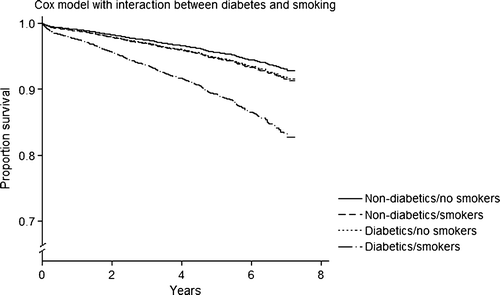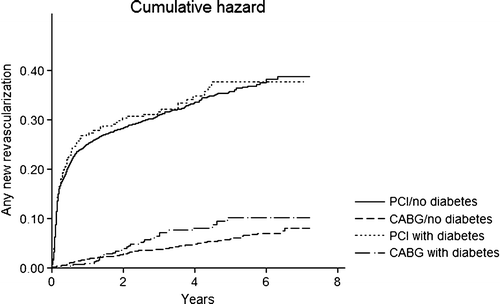Abstract
Objectives. The aim of the present study was to compare the extent of coronary disease and subsequent survival in diabetics and non-diabetics. Design. From the database at Feiring Heart Clinic 13 511 patients were identified with no previous revascularization and were examined with coronary angiography in the period from March 1999 to December 31, 2005. In the cohort 1 475 patients were diabetics. Their survival status of May 31, 2006 was ascertained through the Norwegian National Registry. Results. Diabetics were more symptomatic and had a more severe coronary artery disease at the time of referral with more than 40% having three vessel disease. The unadjusted survival was lower in the diabetics. After adjustment through Cox regression, diabetes mellitus remained a risk factor for subsequent death (overall hazard ratio 1.33), with the excess mortality mainly residing in smoking diabetics. Conclusions. Diabetics were more severely diseased at the time of referral. In Cox regression diabetes mellitus remained a significant risk factor for death in smokers except in the cohort treated with CABG.
It has been known for a long time that patients with diabetes mellitus have a higher mortality of cardiovascular disease than the general population Citation1. This has been attributed to an accelerated coronary atherosclerosis and a higher frequency of complications of coronary disease Citation2–4. The diabetic population constitutes a substantial subgroup of patients with coronary artery disease Citation4. Given the fact that the prognosis of diabetic patients with coronary artery disease is less favorable than the general population, one would assume that diabetics would benefit from an aggressive treatment policy and early referral to invasive evaluation.
A number of studies have been published reporting the relative merits of percutaneous coronary intervention (PCI) and coronary artery bypass grafting (CABG) in diabetics Citation4–9. The general pattern is that diabetic patients have an improved survival if treated with CABG compared to PCI as the initial strategy.
The aim of the present study was to compare the extent of coronary artery disease in diabetics to that of non-diabetics at the time of referral to an invasive centre and to evaluate their subsequent survival in relation to extension of disease and initial treatment.
Feiring Heart Clinic has been conducting PCI and open heart surgery since 1989. From 1999 a common database has been used in surgical and cardiological department. The clinic is a high volume centre both on institutional level and operator level with an average of 1 100 open heart surgical procedures and 1 700 PCI procedures yearly in this period.
Materials
Patients were identified from the institution's database containing data on demographics, clinical and angiographic parameters, treatment, diagnoses (ICD 10) and surgical operative codes (Nordic Medico-Statistical Committee Classification of Surgical Procedures, NCSP). Their survival status as of May 31, 2006 was established through the Norwegian National Registry.
Details have previously been described Citation5. A total of 17 680 patients had been examined with coronary angiography between March 1999 and December 31, 2005. Of these 1 180 patients were excluded from further analyses either because they were treated for a concomitant valvular disease (mainly aortic valve replacement n = 902) or some crucial information was lacking in the database (n = 117). A total of 1 327 patients had had a previous PCI, 1 060 previous CABG, and 485 patients had gone through both treatments before the index admission, and were excluded from further analyses. Thus, 13 511 patients remained in the cohort with 1 475 diabetics and 12 036 non-diabetics. Intervention was judged unnecessary in 4 360 patients and impossible in 377 patients. The initial treatment strategy was PCI in 4 820 and CABG in 3 954 patients. The diagnosis of diabetes mellitus was identified from the medical history as given in the database and ICD10 codes. The entries in the database were continuously validated by dedicated physicians in the cardiological and surgical department.
Statistical analyses
Continuous covariates were evaluated by the Kruskal-Wallis test for differences between the cohorts, and categorical covariates assessed by Fisher's exact test or χ2 test. Univariate analyses of survival were performed using Kaplan-Meier product limit estimator and log-rank tests, and survival adjusting for baseline risk factors was evaluated in a multivariate Cox proportional hazard model Citation10. The Cox model was built by a forward selection procedure. In the multivariate analyses missing values for covariates were substituted by imputation using a best subset multiple regression based on the other covariates. Continuous covariates were evaluated for linearity in log hazard by quartile plots and the by the method of fractional polynomials. Ordinal variables were entered as dummy variables and each coefficient was evaluated for significance and linearity in log hazard. The proportional-hazards assumption in the Cox model was checked by tests based on Schoenfeld residuals, by including interaction term with time, log time and time split in intervals.
Interaction terms were kept in the model if they were statistical significant and biological interesting. The final model was evaluated by the linktest, Grønnesby-Borgan test for goodness of fit Citation11 and by plotting the Cox-Snell residuals versus Nelson-Aalen cumulative hazard function. The results from the Cox regression are given as hazard ratios (HR) with 95% confidence interval (CI).
Results
Extent of disease
A total of 13 511 patients with no previous PCI or CABG, were included in the analyses. Among these 1 475 were diabetics. Insulin dependent diabetes was present in 429 patients. They had identical survival rates to the non insulin dependent cohort, and all diabetics are therefore analyzed as one group. Baseline characteristics are given in . The diabetic population was older, had a lower ejection fraction, more severe symptoms and more frequently hypertension and previous myocardial infarction. Furthermore there was a significant difference in the extent of the coronary disease at baseline. In the diabetic group no coronary disease was rare and three vessel disease much more frequent than in the non-diabetic cohort.
Table I. Baseline characteristics.
Mortality
The total crude mortality was 5.6% (679 deaths) in the non-diabetics population and 8.8% (130 deaths) among the diabetics. The short term (30 days) mortality was 0.75% in the diabetic cohort and 0.47% in the non-diabetic (p = 0.17, Fisher's exact test). The median observation time was 3.5 years (interquartile range 2.0–5.0) in the non-diabetic cohort and 3.0 years (interquartile range 1.7–4.7 years) in the diabetic subgroup. The univariate Kaplan-Meier estimates of survival in diabetics and non-diabetics are depicted in . The log-rank test demonstrated a highly significant difference in survival between the cohorts (p < 0.001). The covariates from were used to build a multivariate Cox model. The following twelve main effects were found significant in a forward selection procedure: age, ejection fraction, left ventricular end diastolic pressure, gender, smoking, ischemia at exercise ECG, CCS function class, diabetes, three vessel disease, generalized arteriosclerosis, other significant disease and hypertension. The proportional hazard test based on Schoenfeld residuals was globally significant, but the slopes of the plotted smoothed curves were very close to zero for all covariates. When interacted with time split in two years interval no covariate was significant after Bonferroni adjustment. When interacted with time or ln time ejection fraction, CCS functional class and three vessel disease were significant after Bonferroni adjustment. These covariates were therefore also tested as stratification variables instead of covariates. However, the model yielded practically identical results either way. The model was therefore kept without stratification and time varying covariates. Using age as squared term in the model the link-test was negative (p = 0.65). Grønnesby-Borgan test was not significant (p = 0.35) with no significant subgroups. A plot of Cox-Snell residuals versus Nelson-Aalen estimate of cumulative hazard was showing the estimates to follow closely a line with 45 degree slope, indicating acceptable fit.
Figure 1. Unadjusted survival estimates in non-diabetics and diabetics. The difference is statistical significant (p < 0.001, log-rank test).
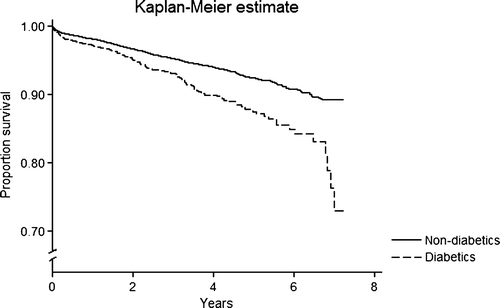
One interactions was kept in the model as statistical significant and biologically interesting, namely diabetes and smoking (p = 0.007). Thus the final model was fitted with twelve main effects and one interaction term and no time varying covariates. The model contained data from all patients including those without angiographic coronary heart disease.
Diabetes remained a significant predictor of mortality in the model (HR 1.33 95% CI 1.10–1.61, p = 0.004), but after inclusion of the interaction term, the main excess mortality resided in the subgroup of diabetics that smoked (). The hazard ratio for diabetics versus non-diabetics in smokers was 2.13 (95% CI 1.43–3.16, p = 0.0002), while it was 1.18 (0.95–1.47, p = 0.13) in non-smokers. Practically identical results were obtained if the population analyzed was restricted to exclude patients with angiographic normal coronary arteries (n = 10 828).
Revascularization
There were differences in initial treatment strategies between the cohorts (). A significantly higher percentage of the non-diabetic patients were not treated with any revascularization procedure (33.6% versus 21.6%, p < 0.001). In this subgroup there was no significant difference in unadjusted survival (p = 0.24, log-rank test). The cohort where intervention was not possible was larger among the diabetics than non-diabetics (4.1% versus 2.6% respectively, p < 0.001, Fisher's exact test), and the diabetics in this subgroup had a particularly high mortality rate () with a hazard ratio compared to non-diabetics of 2.34 (95% CI 1.36–4.04, p = 0.002) in a Cox model where age and ejection fraction were the only other significant covariates.
Figure 3. Survival curves from Cox model with age, ejection fraction and diabetes as significant covariates in the subgroup where intervention was deemed not possible. The difference in survival between diabetics and non-diabetics is highly significant (p = 0.002) with a hazard ratio of 2.34 (95% CI 1.36–4.04).
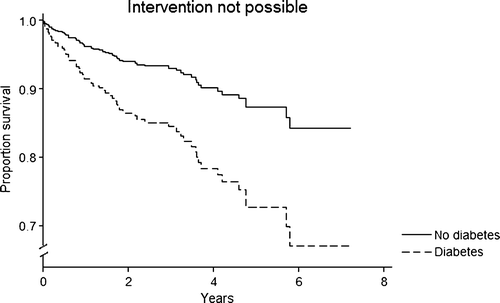
Table II. Initial revascularization treatment strategy.
The cohort where interventions were performed contained 8 774 patients of which 1 096 were diabetics. The distribution of baseline parameters between diabetics and non-diabetics in this subgroup was nearly identical to the total cohort depicted in . A new Cox model was constructed for this subgroup by backward elimination of covariates from the original Cox model containing data from the complete cohort and adding type of revascularization as a dichotomous variable. Hypertension and left ventricular end diastolic pressure were then no longer significant and were removed from the model. The new model was tested for interactions and two statistically significant and biologically interesting interactions were found between diabetes and smoking (p = 0.012) and between choice of strategy and presence of three vessel disease (p = 0.007). The model was fitted with eleven main effects and two interaction terms. In this model diabetes was still an important risk factor for death in smokers with hazard ratio of 2.12 (1.38–3.27, p = 0.001), but not in non-smokers (HR 1.12, 95% CI 0.87–1.44, p = 0.38). A further subgroup division into type of revascularization strategy revealed that in the PCI treated cohort (n = 4820) diabetes retained an increased hazard ratio in smokers of 2.97 (95% CI 1.65–5.35, p < 0.001) and not significantly increased in non-smokers (HR 1.22, 95% CI 0.84–1.78, p = 0.31) (). In the CABG cohort (n = 3 954), however, the interaction between smoking and diabetes was not significant (p = 0.225) and the increased risk in diabetics was abolished with a hazard ratio of 1.15 (95% CI 0.85–1.54, p = 0.34) (). In the CABG group internal mammary artery graft was used in 96.8% of non-diabetic patients and 96.2% in diabetics (p = 0.41, Fisher's exact test).
Figure 4. Survival curves from Cox model in the PCI treated cohort showing the interaction between diabetes and smoking with a significantly higher mortality rate in the diabetics that smoked (p = 0.012 for the interaction term).
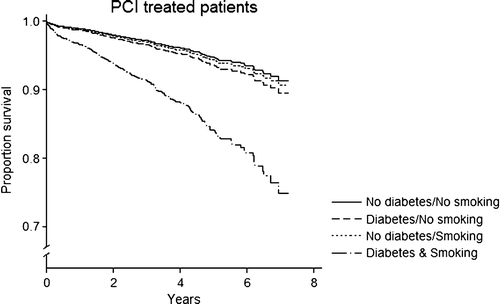
Figure 5. Survival curves from Cox model in patients treated with CABG. In this subgroup neither the interaction term between diabetes and smoking is significant (p = 0.225) nor the increased hazard ratio for diabetics (p = 0.34).
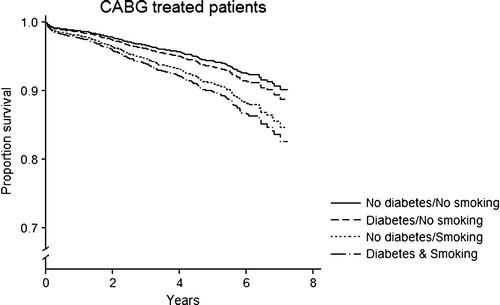
The first reintervention rates in subgroups with and without diabetes and mode of initial intervention are depicted in . PCI has a hazard ratio of 6.87 (95% CI 5.85–8.07) compared to CABG for a subsequent intervention (p < 0.001), while the overall first reintervention rate in diabetics was not different from non-diabetics (HR 1.15 95% CI 0.98–1.34). If reinterventions with new PCI or new CABG were analyzed separately, initial PCI had an increased hazard ratio to CABG in both analyses, while diabetics had identical rate to non-diabetics concerning new PCI, but initial PCI had an increased rate of new CABG in diabetics () with a hazard rate of 2.85 (95% CI 1.86–4.37, p < 0.001) compared to non-diabetics.
Discussion
The association between diabetes mellitus and coronary heart disease has been known for years Citation1–4, and it is reasonable to believe that the more serious prognosis in diabetics with coronary heart disease is common knowledge in the general medical community. Already in 1990 Haffner et al. Citation12 made a case for a more aggressive treatment of cardiovascular risk factors in diabetics. It is therefore a surprising observation that at the time of referral to the invasive evaluation the diabetics were more symptomatic and had a more serious coronary disease than the non-diabetic population (). It is especially noteworthy that more than 40% of the diabetics had three vessel disease at the initial angiographic examination.
The increased morbidity in the present diabetic population is reflected by the increased death rate both evaluated univariately in the Kaplan-Meier estimate and in the multivariate Cox model ( and ). This is in concert with previous observations Citation6, Citation7, Citation13–15.
The Cox model had an interesting interaction between smoking and diabetes. The interaction induced a significantly increased hazard ratio of 2.90 (95% CI 1.97–4.29) in smoking diabetics versus 1.33 (95% CI 1.05–1.69) in non-smoking diabetics compared to non-smoking non-diabetics. Smoking is a well known risk factor in diabetes, and has been implicated both in the development of the disease Citation16, Citation17 and as an important factor contributing to complications and mortality in diabetics Citation18–20. The present results indicate that smoking increases the risk of death relatively more in diabetics than non-diabetics, implying that smoking cessation is even more compelling in diabetics.
Separate analyses in the cohorts with different types of intervention revealed an interesting pattern. The interaction between smoking and diabetes was still present in the PCI treated group with a considerably increased mortality rate in smoking diabetics. In the CABG treated group, however, neither the interaction between smoking and diabetes nor the increased hazard rate for diabetics were any longer statistically significant. This is similar to what recently was reported from the Netherlands Citation21.
Concerning first reinterventions only those performed in the Feiring Heart Clinic are included in the analyses. It is however very unlikely that any systematic difference in the rate of revascularizations performed at other institutions exists between diabetics and non-diabetics. No significant difference in new PCI's existed between the groups, but diabetics initially treated with PCI had a higher rate of subsequent CABG than the non-diabetic counterpart.
The results of the present study supports previous observations of an improved survival in diabetics treated with CABG compared to PCI, especially in three vessel disease Citation4–9, Citation13, Citation15.
It is reasonable to postulate that the difference in effect on diabetes as a risk factor for death between PCI and CABG is due to some inherent feature of the one of the procedures. One explanation could have been an increased restenosis rate in the diabetic group. In that case one would expect an increased rate also in subsequent PCI in the diabetic group and not only increased rate in subsequent CABG (, 7). One explanation for the higher mortality in diabetics with coronary disease has been ascribed to a more rapid acceleration of the arteriosclerotic process Citation2–4. It is therefore tempting to suggest that the effect of CABG could be a hemodynamic “protection” against the development of new lesions centrally located in the coronary arteries, an effect not obtained by PCI, and which could explain the present results.
The present study is an observational study from a single institution's database and as such is subject to the usual difficulty in correcting for selection bias. In addition the cohort has been recruited in the elapse of six years during which standard treatment with both devices and drugs have changed.
In conclusion diabetics are more symptomatic, have a more serious coronary artery disease and a worse prognosis at the time of referral to invasive evaluation. The only subgroup where diabetes is no longer a risk factor for death is in patients treated with CABG. The results of this study justify a suggestion of a more aggressive approach to the detection and treatment of coronary artery disease in diabetics, and underline the importance of CABG as a preferred revascularization treatment in this group.
Acknowledgements
I am in debt to Drs. Rasmus Moer, Sven Martin Almedal and Per Halvorsen for continuing quality control of the database and export of data. There is no conflict of interest.
References
- Kannel WB, McGee DL. Diabetes and cardiovascular disease: The Framingham study. JAMA. 1979; 241: 2035–8
- Mølstad P, Nustad M. Acute myocardial infarction in diabetic patients. Acta Med Scand. 1987; 222: 433–7
- Jacoby RM, Nesto RW. Acute myocardial infarction in the diabetic patient: Pathophysiology, clinical course and prognosis. J Am Coll Cardiol. 1992; 20: 736–44
- Niles NW, Grath PD, Malenka D, Quinton H, Wennberg D, Shubrooks SJ, et al. for the Nothern New England Cardiovascular Disease Study Group. Survival of patients with diabetes and multivessel coronary artery disease after surgical or percutaneous coronary revascularization: Results of a large prospective study. J Am Coll Cardiol. 2001; 37: 1008–15
- Mølstad, P. Coronary artery heart disease: Significance of initial treatment strategy on subsequent long term survival. A comparison of percutaneous coronary intervention and coronary artery bypass grafting in a single centre. Scand Cardiovasc J. 2007, (accepted for publication).
- The BARI Investigators. Seven-year outcome in the bypass angioplasty revascularization investigation (BARI) by treatment and diabetic status. J Am Coll Cardiol. 2000; 35: 1122–9
- King SB 3rd, Kosinski AS, Guyton RA, Lembo NJ, Weintraub WS. Eight-year mortality in the Emory Angioplasty versus surgery trial (EAST). J Am Coll Cardiol. 2000; 35: 1116–21
- Feit F, Brooks MM, Sopko G, Keller NM, Rosen A, Krone R, et al. Long-term clinical outcome in the Bypass Angioplasty Revascularization Investigation Registry: Comparison with the randomized trial; BARI Investigators. Circulation. 2000; 101: 2795–802
- Detre KM, Guo P, Holubkov R, Califf RM, Sopko G, Bach R, et al. Coronary revascularization in diabetic patients: A comparison of the randomized and observational components of the Bypass Angioplasty Revascularization Investigation (BARI). Circulation. 1999; 99: 633–40
- Cox D. Regression models and life tables. J R Stat Soc B. 1972; 34: 187–220
- Hosmer DW, Lemeshow S. Regression modeling of time to event data. John Wiley & sons Inc, New York 1999
- Haffner SM, Lehto S, Rönnemaa T, Pyörälä K, Laakso M. Mortality from coronary heart disease in subjects with type 2 diabetes and in nondiabetic subjects with and without prior myocardial infarction. N Engl J Med. 1998; 339: 229–34
- Brener SJ, Lytle BW, Casserly IP, Topol EJ, Lauer MS. Propensity analysis of long-term survival after surgical or percutaneous revascularization in patients with multivessel coronary disease and high-risk features. Circulation. 2004; 109: 2290–5
- Smith PK, Califf RM, Tuttle RH, Shaw LK, Lee KL, Delong ER, et al. Selection of surgical or percutaneous coronary intervention provides differential longevity benefit. Ann Thorac Surg. 2006; 82: 1420–9
- Hannan EL, Racz MJ, Walford G, Jones RH, Ryan TJ, Bennett E, et al. Long-term outcomes of coronary-artery bypass grafting versus stentimplantation. New Engl J Med. 2005; 352: 2174–83
- Will JC, Galuska DA, Ford ES, Moktad A, Calle EE. Cigarette smoking and diabetes mellitus: Evidence of a positive association from a large prospective cohort study. Int J Epidemiol. 2001; 30: 540–6
- Solberg LI, Desai JR, O'Connor PJ, Devlin HM. Diabetic patients who smoke: Are they different?. Ann Fam Med. 2004; 2: 26–32
- Al-Delaimy WK, Speizer FE, Willett WC, Hu FB, Manson JE. Smoking and mortality among women with type 2 diabetes. Diabetes Care. 2001; 24: 2043–8
- Haire-Joshu D, Glasgow RE, Tibbs TL. Smoking and diabetes. Diabetes Care. 1999; 22: 1887–98
- Moy CS, LaPorte RE, Dorman JS, Songer TJ, Orchard TJ, Kuller LH, et al. Insulin-dependant diabetes mellitus mortality. The risk of cigarette smoking. Circulation. 1990; 82: 37–43
- Timmer JR, Breeman A, Ottervanger JP, de Kluiver EP, Boonstra PW, Zijlstra F. Long-term clinical outcome of patients with diabetes proposed for coronary revascularisation. Neth J Med. 2006; 64: 296–301
